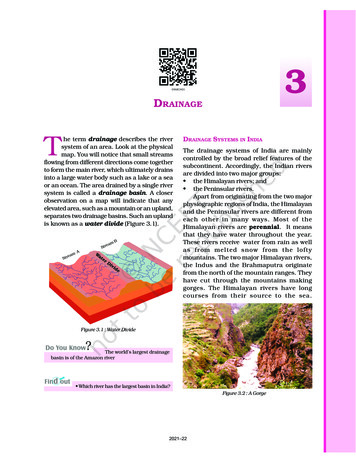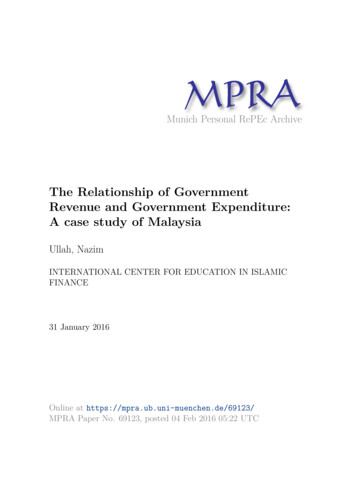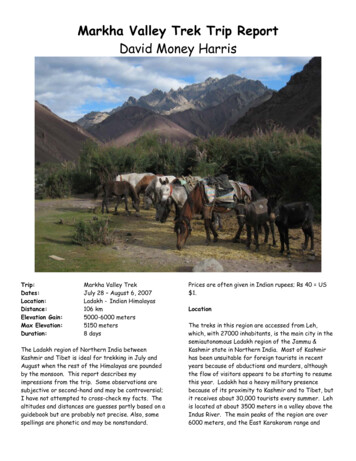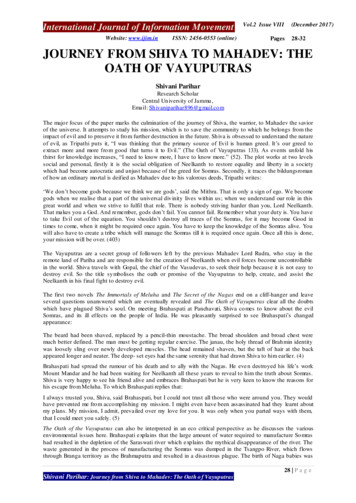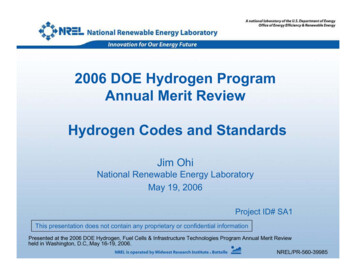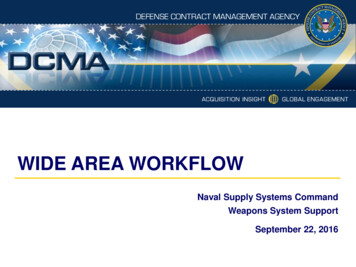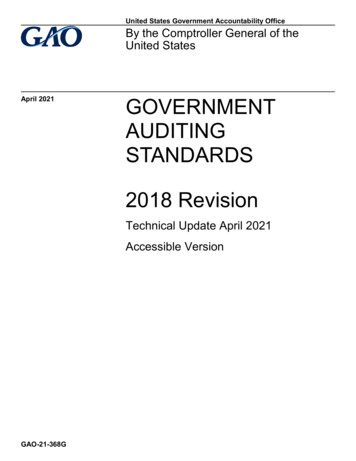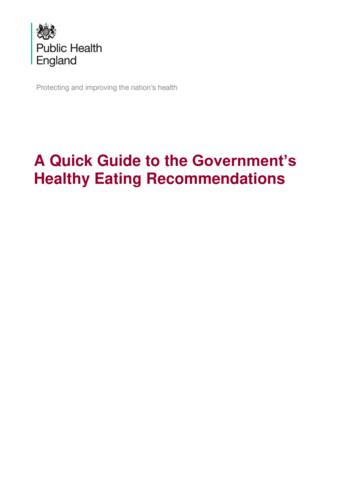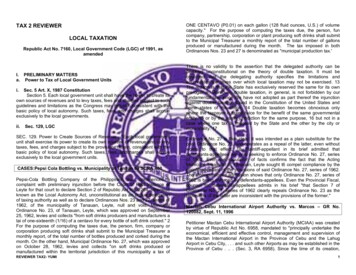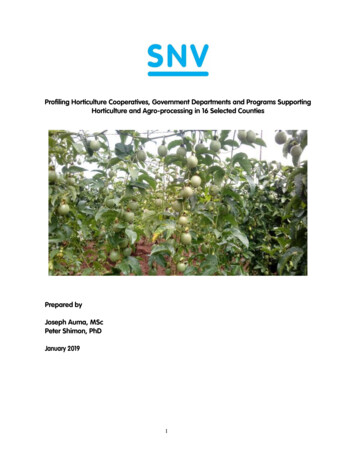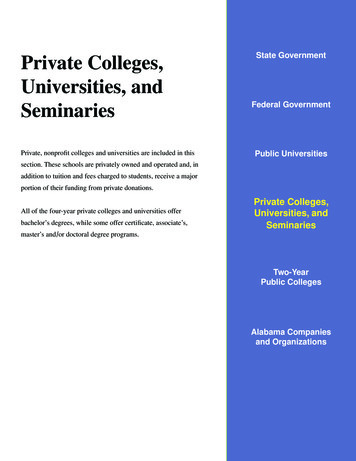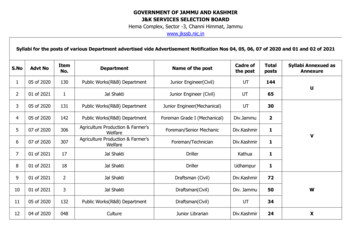
Transcription
GOVERNMENT OF JAMMU AND KASHMIRJ&K SERVICES SELECTION BOARDHema Complex, Sector -3, Channi Himmat, Jammuwww.jkssb.nic.inSyllabi for the posts of various Department advertised vide Advertisement Notification Nos 04, 05, 06, 07 of 2020 and 01 and 02 of 2021S.NoAdvt NoItemNo.DepartmentName of the postCadre ofthe postTotalposts105 of 2020130Public Works(R&B) DepartmentJunior Engineer(Civil)UT144Syllabi Annexued asAnnexureU201 of 20211Jal ShaktiJunior Engineer (Civil)UT65305 of 2020131Public Works(R&B) DepartmentJunior Engineer(Mechanical)UT30405 of 2020142Public Works(R&B) DepartmentForeman Grade I (Mechanical)Div.Jammu2507 of 2020306Foreman/Senior MechanicDiv.Kashmir1607 of 2020307Foreman/TechnicianDiv.Kashmir1701 of 202117Jal ShaktiDrillerKathua1801 of 202118Jal ShaktiDrillerUdhampur1901 of 20212Jal ShaktiDraftsman (Civil)Div.Kashmir721001 of 20213Jal ShaktiDraftsman(Civil)Div. Jammu501105 of 2020132Public Works(R&B) DepartmentDraftsman(Civil)UT341204 of 2020048CultureJunior LibrarianDiv.Kashmir24Agriculture Production & Farmer'sWelfareAgriculture Production & Farmer'sWelfareVWX
1304 of 2020049CultureJunior LibrarianDiv.Jammu241404 of 2020046CultureLibrarianDiv.Kashmir41507 of 2020333Skill DevelopmentLibrarianDiv.Jammu21604 of 2020054CultureCataloguerUT11704 of 2020047CultureLibrarianDiv.Jammu11801 of 202165HorticultureLibrarianDiv.Kashmir11901 of 2021117InformationPhoto LibrarianDiv. Jammu12005 of 2020151Law, Justice and ParliamentaryAffairsLibrarianUT12107 of 2020317Skill DevelopmentAssistant Librarian2207 of 2020310Skill DevelopmentLibrarian2306 of 2020203Higher EducationLibrary AssistantDiv.Kashmir272406 of 2020189Higher EducationLibrary AssistantDiv.Jammu152504 of 2020062CultureLibrary AssistantDiv.Kashmir12604 of 2020110FinanceLibrary AssistantUT12707 of 2020316Skill DevelopmentLibrary AssistantDivKashmir12807 of 2020326Skill DevelopmentLibrary AssistantDiv Jammu114702 of 2021408Health & Medical EducationLibrary AssttDiv.Jammu1DivKashmirDivKashmir11Y
2902 of 2021178Health & Medical EducationLibrary AssistantDiv.Jammu33002 of 2021223Health & Medical EducationLibrary AssistantDiv.Kashmir23104 of 2020113FinanceJunior Statistical AssistantDiv.Jammu51AD3204 of 2020107FinanceJunior Statistical AssistantDiv.Kashmir403304 of 2020099ElectionElection Assistant (Junior Scale)UT1103402 of 2021475RevenuePatwariBaramulla473502 of 2021464RevenuePatwariKupwara363602 of 2021468RevenuePatwariShopian173702 of 2021471RevenuePatwariBandipora163802 of 2021458RevenuePatwariAnantnag153902 of 2021455RevenuePatwariPulwama114004 of 2020106FinanceAccounts AssistantUT972AF4106 of 2020231HomeLaboratory AssistantUT19ATGrand Total1848AE
ANNEXURE “U”Syllabus for Written testMarks 120120 Minutes1. Surveying:10 MarksImportance of surveying, principles and classifications, measurements ofdistance and directions, chain surveying, compass surveying, leveling,tachometry, theodolite, traversing, contouring, plane table surveying, curves.2. Mechanics and Structural analysis:15 MarksIntroduction, Concept of rigid body scalar and vector quantities, Laws of force,moment, friction, Centre of gravity, simple machines, torsion, Properties ofmaterial, Bending moment and shear force in statically determinate beams.Simple stress and strain relationship. Stress and strain in two dimensions,principal stresses, stress transformation. Simple bending theory, flexural andshear stresses, unsymmetrical bending, shear Centre. Thin-walled pressurevessels, uniform torsion, buckling of column, combined and direct bendingstresses. slope and deflection, Analysis of trusses3. RCC Structures:15 MarksConcrete technology, Ingredients of concrete, water cement ratio, workabilityproperties of concrete, admixtures, special concretes, Nondestructive tests,basics of mix design. Concrete design-basic working stress and limit statedesign concepts, analysis of ultimate load capacity and design of memberssubjected to flexure, shear, compression and torsion by limit state methods.Basic elements of pre-stressed concrete, analysis of beam sections at transferand service loads, one-way slab, two-way slab.4. Soil Mechanics:10 MarksOrigin of soils, properties, soil classification, three phase system, fundamentaldefinitions, relationship and interrelationship, flow of water through soils,permeability & seepage, effective stress principle, deformation of soils,consolidation, compaction, shear strength characteristics, plate load test, SPT,Density control, Measurement of field density by core cutter and sandreplacement method, soil exploration, bearing capacity and its methods5. Fluid Mechanics and Hydraulics:1 5 MarksProperties of fluids, hydrostatic pressure, measurement of pressure, flowmeasurements, flow through pipes, flow through open channels, hydraulicpumps, principle of conservation of mass, momentum, energy andcorresponding equations, potential flow, applications of momentum andBernoulli’s equation, laminar and turbulent flow, flow in pipes, pipe networks.Concept of boundary layer and its growth. Uniform flow, critical flow andgradually varied flow in channels, specific energy concept, hydraulic jumpForces on immersed bodies, flow measurements in channels, tanks and pipes.Dimensional analysis and hydraulic modeling Kinematics of flow.
6. Irrigation Engineering:10 MarksIntroduction, water requirement of crops, hydrological cycle, Dams, Canals,dams, canal head works and regulatory works, cross drainage works, hydraulicstructures, river training works, water-logging, drainage, ground waterrecharge, well hydraulics.7. Water supply and waste water Engineering:10 MarksIntroduction, quantity of water, quality of water, water treatment, conveyanceof water, laying out of pipes, building water supply, water supply fixtures andinstallation, plumbing, sewerage system, laying and construction of sewers,sewage characteristics, Methods of disposal, sewage treatment, buildingdrainage, air and noise pollution8. Highway Engineering:10 MarksHistory of development of highway and planning, Definitions of various termsused in highway engineering., Methods of road construction, IRC classification,Highway surveys and plans Geometric design, Different types of road materialsin use, Binders, Types of pavement, CBR method, sub grade preparation, WBM,WMM, Bituminous Macadam, dense bituminous macadam, special problems inhill road.9. Railway Engineering:10 MarksHistory of Indian railways, Gauges used, permanent way its components, Typesof rails, creep, welding, Rail fixtures and fastenings, Signaling, Points andCrossings, Bridge terminology, classification, components, foundations.10. Construction planning management:15 MarksNetwork diagrams, PERT-CPM, cost optimization contracts, tenders,depreciation, valuation, organization, measurement books, cash book,functions of management, construction planning, quality control, inventorycontrol, Estimation and costing definitions, methods of estimation and type ofestimates.***************
ANNEXURE “V”Syllabus for Written testMarks 120120 MinutesTheory of Machines and Machine Design:15 MarksFour bar linkage and link motion, Flywheels and fluctuation of energy, Powertransmission by belts-V-belts and Flat belts. Gears-Type of gears, gear profileand gear ratio calculation. Cams. Governors-Principles and classification.Design of keys, shafts, Riveted joint, couplings.Engineering Mechanics and Strength of Materials:15 MarksLaws of forces, Equilibrium of Forces, Moment of Inertia, Laws of motion.Friction. Concept of simple machines, M A, V R, %age. Concepts of stress andstrain, Elastic limit and elastic constants. Bending moments and shear forcediagram. Stress in composite bars. Torsion in circular shafts. Columns: Euler’sand Rankine’s theories. Thin-walled pressure vessels.Thermal Engineering and Refrigeration & Air-conditioning:20 MarksThermodynamics: Heat, work and temperature, First and second laws ofthermodynamics. Carnot, Rankine, Otto and Diesel Cycles. P-v & P-T diagramsH2O. Saturated, wet & superheated steam. Definition of dryness fraction ofsteam, degree of superheat of steam. Rankine cycle of steam: Simple Rankinecycle, plot on P-V, T-S, h-s planes, Rankine cycle efficiency with & withoutpump work. Concept of COP, Carnot Cycle, Vapour compression cycle.Refrigerants. Psychometry, DBT, WBT, DPT.Fluid Mechanics & Machinery:15 MarksProperties & Classification of Fluids, Newton’s law of viscosity, Fluid Statics,Measurement of Fluid Pressure by Manometers, U-tube, Inclined tube. FluidKinematics: Stream line, laminar & turbulent flow, external & internal flow,continuity equation. Dynamics of ideal fluids: Bernoulli’s equation, Total head;Velocity head; Pressure head. Measurement of Flow rate, Basic Principles &working of Venturi meter, Pitot tube, Orifice meter. Hydraulic Turbines &Centrifugal PumpsMaterial Science & Production Engineering:20 MarksStructure of metals, Space lattice, Unit cell, BCC, FCC etc. Iron carbon diagram,Classification of Steels: mild steel & alloy steel. Heat treatment of steel. Welding
– Arc Welding, Gas Welding, Resistance Welding, Special Welding Techniquesi.e. TIG, MIG. Brazing & Soldering, Welding Defects & Testing. Foundry &Casting methods, defects, different casting processes. Forging, Extrusion etc.Metal cutting principles, cutting tools. Basic Principles of machining with Lathe,Milling, Drilling, Shaping, Grinding. Machine tools & manufacturing processes.Metrology and Automobile Engineering:15 MarksTools used in Linear Measurements, Angular Measurement, Surface finish.Limits, fits & Tolerance, Error, Classification of Automobiles. Transmission,Steering, Braking, Suspension system. IC Engine Performance, IC EngineCombustion process, Cooling and Lubrication system in I.C EngineIndustrial Management and CAD/CAM:20 MarksPlanning, Organizing, Leading, Controlling. Inventory Control, Inspection &Quality Control. Basic concepts of CAD/CAM. NC, DNC, CNC machines.*****************
ANNEXURE “W”Syllabus for Written testMarks 120UNIT 1i.ii.iii.iv.v.vi.vii.viii.ii.iii.iv.v.25 marksDrawing is a language of technicians. Drawing office organization. Drawinginstruments, equipment’s materials their use, care & maintenance, safetyprecautions. Introduction to BIS code of practice and Architectural drawings.Importance of lettering, printing of letters and figures sizes, proportion etc. asper BIS code.Forms and proportions for single stroke lettering, Lettering stencils.Geometrical drawing. Definitions, construction of plain geometrical figures.Orthographic projection, dihedral angles and recommended methods ofprojection according to B.I.S codes.Principles, representation and construction of different types of scales, graphicscales, recommended scales for drawing with reference to BIS codes.Dimensioning technique, order of finishing, technical, Sketching, technique ofsketching model drawing, orthographic sketching etc.Conventional signs and symbols as per B.I. S. Bricks characteristics of goodbricks, hollow bricks and manufacture of bricks.Tiles, terracotta, stone ware and earthen ware, sand types, characteristics,cement, lime.UNIT 2i.120 Minutes30 marksSequence of construction of a building. Names of different parts of building.Bricks masonry- principles of construction of bonds. Tools and equipment used.Scaffolding.Stone masonry, terms used, principles of construction, classification, compositemasonry and strength of walls. Timber: Structure- Indian timber uses.Foundation: Purpose, causes of failure of foundation, bearing capacity of soils,dead and live loads, examination of ground. Types of foundation. Drawing offooting foundation, setting out of building on ground excavation, shorting &simple machine foundations.Dampness in building and damp proof course. Method of prevention ofdampness in building. Mortar-types, proportion & mixing. Plastering & pointing.White washing & distempering.Types of ground floor and methods of constructing granolithic, mosaic, bricktiles etc. floors.
.xix.Arches-technical terms forms –brick and stone centering lintel. Market formsand sizes.Carpentry joints-terms, Classification of joints.Door- parts of door, location, sizes, and types.Windows and ventilators including steel window and ventilators fixtures andfastenings used in doors. Window and ventilators.Roof-Pitched roof types, roof covering, component parts of roof. Theory oftrussing king and queen post trusses.Classification and construction of upper floors including waterproofing, generalPrinciples of construction of masonry & R. C.CStairs: Terms, forms, materials planning and designing of Stairs. Details ofconstruction.Residential building. Principles of planning. Orientation-local building by law asincluding BIS code, type of residential building rooms, services, utilities whichconstitute as dwelling house. Estimating.Method and find out quantities for a single storied residential building.Perspective view types. Method of construction, technique of colouring andshading.Inking & tracing, operating of Leroy set & care of its accessories. Method ofpreparing Blue prints or Ammonia Prints, Folding of prints.Safety precaution& elementary first aid, forge and fuel. Lighting fire Commonhad tools-their description and use. Description of plumbing operations.Safety precautions & elementary firs aid- carpenter’s hand tools, their names,description and use. Common joints. Use of nails, screws hinges, dowels etc.preparation of glue & putty, Grinding & sharpening of tools. Their care &maintenance. Use of different types of joints. Properties and uses of differenttimbers used in construction work.Safety precautions and elementary first aid. Artificial respiration and treatmentof electrical Shock. Elementary electricity. General idea of supply system.Wireman’s tool kits. Wiring materials. Electric fittings. System of wiring. Wiringinstallation for domestic lighting.UNIT 3i.ii.iii.25 marksTools their description, uses and their care.Details of different bonding wall and section according to BISIntroduction:- Chain surveying principles, Instruments employed, use, care &maintenance. Field problems. Field book plotting. Introduction to plane tablesurvey, Instruments employed, use, care & maintenance. Prismatic compass.Planimeterand pentagraph.
iv.v.vi.vii.viii.Instruments and accessories- their uses and description level book. Differentialleveling. Application of chain and leveling to building construction. Plotting,preparation of contour computing earth work by spot level and contours.Setting out work.Road:-Introduction to roads, general principles of alignment . classification andconstruction of different types of roads.Indian railways-their gauges, construction of permanent ways . Different ailsections. Use of stone blasts in railways track. Use and types of slippers, typesof signals, fixtures & fastening in Railway Tracks including base plates andfishplates.Bridges: - Introduction to bridges, component parts of a bridge. Classificationof culverts (I.R.C.)Bridges– types, location of bridge. Tunnels rules used for the sizes of differentmembers.UNIT 4i.ii.iii.iv.v.vi.vii.viii.ix.x.xi.20 marksDefinition of terms used in irrigation.Hydrology like duty delta, intensity of irrigation, Hydrograph, peak flow, runsoff, catchments area CCA, corps like, Rabi, Kharif etc.Storage/ diversion head works definitions:Types of Dam –Masonry, concrete & composite DamsGravity Dam, Arch and Buttress Dams, Earth and Rock fill dams.Reservoir- types of Reservoirs viz. single purpose and multi-purpose,area/ capacity curves of Reservoir.Canals- Canals, classification of canals and distribution system, canal structuresviz. Head Regulators, Cross Regulators, Canal outlet, Escape etc, drawing ofcanal alignment including longitudinal and cross sections of canals with thegiven data.Type of cross drainage Works viz. Aqueducts. Super passage, level crossing,Irrigation , culvert- Inlets and Outlets, General Description , Element of waterpower development and various civil engineering structure of Hydro ElectricSchemes, i. e., fore bay. Penstock, Turbines, Power House etc.Introduction–terms used in public health engineering system of sanitationhouse plumbing, sanitary fitting etc. Types of supply system and purification ofwater.Introduction to RCC uses, materials proportions and form work, includingbending of bars and construction reference to BIS code Reinforced brickwork.Materials used for RCC, construction selection of materials coarse aggregate,fine aggregate cement – water, reinforcement, characteristics. Method ofMixing concrete- hand and machine, slump test.
xii.xiii.Forms of rivets, proportions. Types of riveted joints.Design of Riveted connection, failure of riveted joints.UNIT 5i.ii.iii.iv.v.vi.vii.viii.ix.x.20 marksTypes of estimate, standard method of taking out quantity, Labour & materialdetailed & abstract estimate. Analysis of rates for simple items of work.Schedule of rates, specifications.Residential building, planning of building, local by –laws including BIS codeTypes of residential building rooms, service utilities which constitute a dwellinghouse. Building by –laws of State urban Development authorities,Improvement trust etc.What is a Computer- General terms used in computer.Elementary DOS commands.Window command and their usesAuto CAD commands and use of different Icons of Auto CADKnowledge about different co-ordinate systemsKnowledge about 3d DraftingKnowledge about Architectural Desk top and creating modeling.*******************
Annexure “X”Syllabus for WrittenTotal Marks 120UNIT ITime 02 Hours20 Marks(i)(ii)(iii)(iv)(v)(vi)(vii)Types of Libraries and their FeaturesRole of Libraries in contemporary SocietyFive Laws of Library SciencesLibrary legislations in IndiaDigital LibraryIntellectual Property Rights (IPR)National and International Library Associations:ILA,IASLIC,IATLIS, IFLA, FID ALA, ASLIB etc(viii) National and intercalation Agencies: UNESCO, OCLC, PRRLF, UGC,INFLIBNET, DELNET etc(ix) Information Centres, DRTC, ISI, INSDOC (NISCAIR), NASSDOC,DESIDOC, SENDOC, etcUnit-IIMarks 20(i) Basic Terminology: call Number, Class Number, Book Number, Isolates(ii) Classification; concept & purpose.(iii) Types and characteristics of classification scheme.(iv) ISBD, ISBN, ISSN; classification schemes.(v) Features of DDC, UDC, and CC(vi) Five Fundamental Categories(vii) Notation: Definition and Purpose(viii) Library Catalogue; Definition and purpose(ix) Cannons of Classification and CataloguingUnit-II IMarks 20(i) Principles of Book Selection(ii) Selection Tool; Print and Non-Print Materials(iii) Processing of Documents; Accessioning, Classification, Cataloguing,labelling and shelving(iv) Difference between catalogue, Accession Register, bibliography and Shelflist.(v) Serials/ Journals; Selection and procurement(vi) Book Transaction System: Traditional and Modern(vii) Stock verification of Books; Methods and Tools(viii) Weeding ProcessUnit-IVMarks 20
(i) Information sources: Definition, types and importance;(ii) Information sources- Primary, Secondary and Tertiary.(iii) Information Services: Definition and need of reference, documentationand information services.(iv) Types of Dictionaries, Encyclopaedias(v) Geographical and Biographical Sources(vi) Indexing and Abstracting Sources(vii) Types of Bibliographies(viii) Bibliographies SourcesUnit-VMarks 20(i)(ii)(iii)(iv)(v)(vi)Unit-VITypes of Reference service, Ready reference service, Long RangReference ServiceReference Librarian: Role Skills and CompetencesUser Education/ Information Literacy SkillsCAS/SDIInternational Information System; INIS, AGRIS, MEDLARS/MEDLINE,INSPECInformation Seeking PatternMarks 20(i) Study of Computer including concept of Hardware.(ii) Library Automation Need and Purpose.(iii) Need for computer applications, Areas of computer applications.Automation in library Management. Software Packages for LibraryManagement-Essential features(iv) Computer and its Units, Computer and its classification.(v) Study of Various operating systems.(vi) General-purpose application software: Word Processing such as MSoffice, lotus.(vii) Special Purpose application software: CDS/ISIS.(viii) Library Networking: Needs & Purpose.(ix) OPAC AND Web-OPAC.
Annexure “Y”Syllabus for Written TestTotal Marks 120Time 02 HoursUNIT I20 Marks(i)(ii)(iii)(iv)(v)(vi)TensesRearranging of jumbled sentences.NarrationModelsArticlesComprehension with blanks to be filled in withi. Phrasesii. Pronounsiii. Homonyms / homophones.(vii) Clauses(viii) Synonyms and antonyms(ix)Pairs of words and their use in meaningful sentences.(x)Idioms and phrases.(xi)Uses of Prepositions.(xii) Active & Passive VoiceUNIT II20 Marks(x)(xi)(xii)(xiii)(xiv)(xv)(xvi)Types of Libraries and their FeaturesRole of Libraries in contemporary SocietyFive Laws of Library SciencesLibrary legislations in IndiaDigital LibraryIntellectual Property Rights (IPR)National and International Library Associations:ILA,IASLIC,IATLIS, IFLA, FID ALA, ASLIB etc(xvii) National and intercalation Agencies: UNESCO, OCLC, PRRLF, UGC,INFLIBNET, DELNET etc(xviii) Information Centres, DRTC, ISI, INSDOC (NISCAIR), NASSDOC,DESIDOC, SENDOC, etcUnit-III20 Marks(x) Basic Terminology: call Number, Class Number, Book Number, Isolates(xi) Classification; concept & purpose.(xii) Types and characteristics of classification scheme.(xiii) ISBD, ISBN, ISSN; classification schemes.(xiv) Features of DDC, UDC, and CC(xv) Five Fundamental Categories(xvi) Notation: Definition and Purpose(xvii) Library Catalogue; Definition and purpose
(xviii) Cannons of Classification and CataloguingUnit-IV20 Marks(ix) Principles of Book Selection(x) Selection Tool; Print and Non-Print Materials(xi) Processing of Documents; Accessioning, Classification, Cataloguing,labelling and shelving(xii) Difference between catalogue, Accession Register, bibliography and Shelflist.(xiii) Serials/ Journals; Selection and procurement(xiv) Book Transaction System: Traditional and Modern(xv) Stock verification of Books; Methods and Tools(xvi) Weeding ProcessUnit-V20 Marks(ix) Information sources: Definition, types and importance;(x) Information sources- Primary, Secondary and Tertiary.(xi) Information Services: Definition and need of reference, documentationand information services.(xii) Types of Dictionaries, Encyclopaedias(xiii) Geographical and Biographical Sources(xiv) Indexing and Abstracting Sources(xv) Types of Bibliographies(xvi) Bibliographies SourcesUnit-VI20 Marks(i)(ii)(iii)(iv)(v)(vi)Types of Reference service, Ready reference service, Long RangReference ServiceReference Librarian: Role Skills and CompetencesUser Education/ Information Literacy SkillsCAS/SDIInternational Information System; INIS, AGRIS, MEDLARS/MEDLINE,INSPECInformation Seeking Pattern
Annexure “Z”Syllabus for Written test (Objective Type)Marks: 80Time: 80 MinutesUnit I General i)(xii)(xiii)20 MarksComprehensionEditing / Proof Reading.Rearranging of jumbled sentencesNarrationModalsArticlesParagraph writing with blanks to be filled in with the es etc.ClausesPunctuationSynonyms and antonymsIdioms and phrases.Uses of PrepositionsActive & Passive VoiceUnit II General Awareness with special reference to JK UT 20 Marks(i)(ii)(iii)(iv)(v)(vi)(vii)Current Events of National and International importancePolitical & Physical divisions of IndiaIndian Culture, Heritage and Freedom Struggle/Movement.Demography- Census, its feature and functions.Important Rivers & Lakes in India.Weather, Climate, Crops, Means of Transport of India.J&K UTa) Historyb) Economyc) Geography- (Weather, Climate, Crops, Rivers, Lakes, Flora, Fauna etc.)d) Heritage & Culturee) Important Tourist DestinationsUnit III Numerical and Reasoning Ability20 Marks
Basic Arithmetic:(i)(ii)(iii)(iv)(v)(vi)Number SystemPercentageAverageProfit & LossRatio & ProportionTime & it IV(i)(ii)(iii)(iv)(v)(vi)Number seriesLetter seriesCoding decodingDirection senseBlood relationsMathematical reasoningSpeed, Distance and TimeStatements and conclusions.Basic Concepts of Computers20 MarksFundamentals of computer sciencesHardware & SoftwareInput and output devicesOperating systemM.S Word,M.S Excel, M.S Acess and Powerpoint PresentationE mail & Internet
Annexure “AA”Syllabus for Written Test (Objective Type)Marks: 60Time: 60 MinutesS. No.Subjects/ Topic1234GENERAL AWARENESS with Special reference to J&K UTGENERAL ENGLISH & COMPREHENSIONGENERAL INTELLIGENCE & REASONINGCOMPUTER APPLICATIONSTOTALMarksassigned20201010601. GENERAL AWARENESS with special reference of J&K UT.(ii)(i)(ii)(iii)(iv)(v)(vi)Current Events of National and International importancePolitical & Physical divisions of IndiaIndian Culture, Heritage and Freedom Struggle/Movement.Demography- Census, its feature and functions.Important Rivers & Lakes in India.Weather, Climate, Crops, Means of Transport of India.J&K UTf) Historyg) Economyh) Geography- (Weather, Climate, Crops, Rivers, Lakes, Flora, Fauna etc.)i) Heritage & Culturej) Important Tourist Destinations2. GENERAL ENGLISH & COMPREHENSION(i)Tenses(ii) Narration(iii) Modals(iv) Articles(v) Reading Comprehension(vi) Fill in the blanks with Phrases, Pronouns, homonyms/ homophones etc(vii) Clauses(viii) Synonyms and antonyms(ix) Pairs of words and their use in meaningful sentences.(x) Rearranging of jumbled sentences.(xi) Idioms and phrases.(xii) Uses of Prepositions.(xiii) Active & Passive Voice(xiv) Error Spotting(xv) Sentence Correction(xvi) Spellings Correction
3. GENERAL INTELLIGENCE & REASONING(i) Number series, Letter series, Semantic Series, Speed, Distance andTime, Statements and conclusions, Logical Reasoning, MentalReasoning, Word Building, Numerical Operations, Semantic Analogy,Symbolic/ Number Analogy, Figural Analogy, Semantic Classification,Symbolic/ Number Classification, Figural Classification, Problem Solving.(ii) Symbolic Operations, Trends, Space Orientation, Space Visualization,Venn Diagrams, Drawing inferences, Punched hole/ pattern- folding &un-folding, Figural Pattern- folding and completion, Indexing, Addressmatching, Date & city matching, Classification of centre codes/rollnumbers, Small & Capital letters.4. COMPUTER APPLICATIONS(i)Basic Applications of Computer and its component.(ii) Fundamentals of computer sciences.(iii) Hardware & Software, Concept of Open-Source Technologies.(iv) Input & output Devices.(v) Knowledge of MS Word, MS Excel, MS Access, MS PowerPoint, PDFInternet and E-mail.(vi) Concept of Computer Virus and Latest Anti-Virus.(vii) Terms and Abbreviation used in IT.(viii) Role of Information Technology in Governance
Annexure “AB”Subject: Syllabus for Written Test.Marks 120Constitutional Law:120 Minutes15 Marks(i)(ii)(iii)Salient features of Indian Constitution.Parliamentary form of Government.President of India- Election, Qualifications, Impeachment, Position, Powersand Privileges.(iv)Cabinet System, Collective Responsibility-Individual responsibility,President-Prime Minister relationship(v)Distribution of Legislative Powers (Art. 245, 246 & 254)(vi)Failure of Constitutional Machinery (Art. 356)(vii) Constitutional Amendments – Methods and limitation (Art. 368)(viii) Freedom of Trade and Commerce(ix)Regulatory and Compensatory measures (Articles 301-304).(x)Articles 141 and 143.(xi)Appointment and impeachment of the Judges of the High Courtsand Supreme Court.(xii) Services under the Constitution- Doctrine of Pleasure (Art. 310),Restrictions (Art. 311)(xiii) Fundamental Rights (Articles 14-16, 19-22 and 25-30).(xiv) Constitutional remedies. Writ Jurisdiction(xv) Scope of Article 32(xvi) Scope of Article 226(xvii) Directive Principles of State Policy; Relationship between DirectivePrinciples and Fundamental Rights.(xviii) Emergency Provisions: Arts 352 to 354, 358 and 359.Administrative Law:(i)(ii)(iii)(iv)(v)10 MarksClassification of Administrative Action:Definition of administrative actions.Need for classificationIdentification of legislative actionIdentification of quasi-judicial and administrative actions. Legislativepowers of administration.(vi) Necessity for delegation of legislative powers and its constitutional validity.(vii) Principles of Natural Justice:(viii) No man shall be judge in his own cause.(ix) No man shall be condemned unheard.(x) Administrative Discretion(xi) Need for Administrative Discretion
(xii) Administrative Discretion and rule of law(xiii) Need for safeguards.(xiv) Doctrine of Excessive Delegation of Discretion(xv) Constitutionality of discretionary powers(xvi) Administrative discrimination and arbitrariness(xvii) De tournament De preuvoir(xviii) Malafide exercise of discretion Improper purpose(xix) Irrelevant considerations Unreasonableness(xx) Non-exercise of discretionary powers(xxi) Liability of the Government(xxii) Statutory- immunity(xxiii) Act of State(xxiv) Contractual liability of Government(xxv) Government privileges in legal proceedings(xxvi) Public accountability(xxvii) OmbudsmanMuslim Law:(i)(ii)(iii)(iv)(v)(vi)Sources and Schools of Muslim Law.Nature, scope, validity and classification of marriage under Muslim LawPolygamy, Divorce and matrimonial remedies under Muslim LawDissolution of Muslim Marriage Act, 1939.Maintenance under section 125 of the Code of Criminal Procedure, 1973.Maintenance under Muslim Women (Protection of Rights on Divorce) Act,1986Hindu Law:(i)(ii)(iii)(iv)(v)(vi)(vii)(viii)(ix)(x)05 MarksNature, concept and essential conditions of Hindu Marriage.Grounds of divorce and divorce by mutual consent under Hindu LawMatrimonial remedies under Hindu Law:Nullity of marriageRestitution of conjugal rightsJudicial separationDissolution of marriageJoint family and coparcenary under Mitakshara lawKarta-his powers, privileges and obligations.Adoption and Guardianship.Law of Contract
design concepts, analysis of ultimate load capacity and design of members . plumbing, sewerage system, laying and construction of sewers, . measurement books, cash book, functions of management, construction planning, quality control, inventory control, Estimation and costing defi
